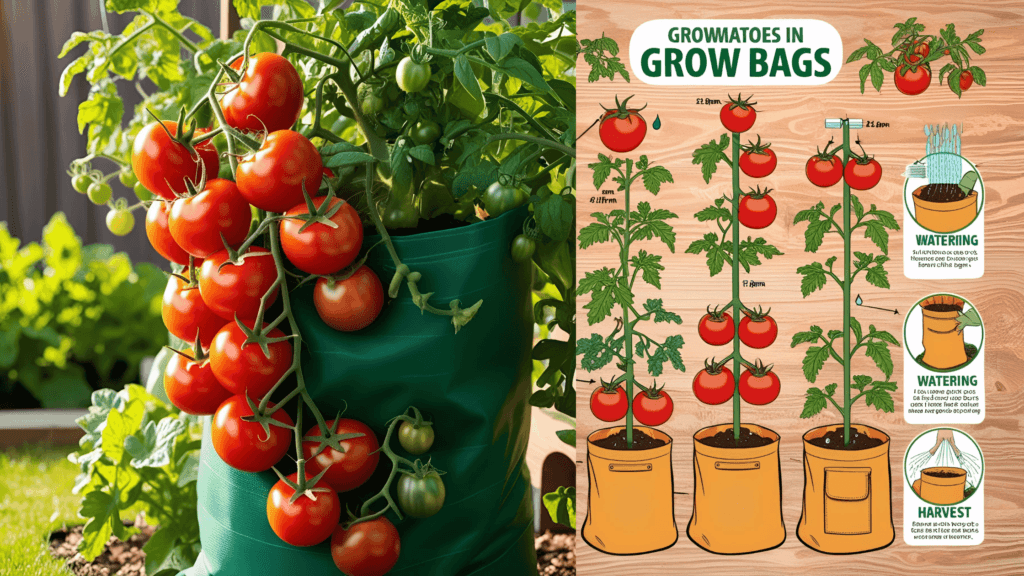
Table of Contents
ToggleGrowing Tomatoes in Grow Bags: A Complete Guide
Dreaming of vine-ripened, juicy tomatoes bursting with flavor? With grow bags tomatoes, you don’t need a sprawling garden to make that dream a reality! Grow bags for tomatoes have emerged as a fantastic solution for urban gardeners, apartment dwellers, and anyone looking for a flexible and efficient way to cultivate delicious fruit.
From Seed to Sauce: Your Complete Guide to Growing Tomatoes in Grow Bags
Dreaming of vine-ripened, juicy tomatoes bursting with flavor? You don’t need a sprawling garden to make that dream a reality! Grow bags have emerged as a fantastic solution for urban gardeners, apartment dwellers, and anyone looking for a flexible and efficient way to cultivate delicious tomatoes.
This complete guide will walk you through everything you need to know to successfully grow tomatoes in grow bags, from choosing the right bag to harvesting your bountiful crop.
Why Choose Grow Bags for Tomatoes?
Before we dive in, let’s explore the many benefits of growing tomatoes in grow bags:
Excellent Drainage: Grow bags are typically made from breathable fabric, allowing excess water to drain freely. This is crucial for tomatoes, which are prone to root rot in soggy conditions.
Aerated Roots: The porous material allows for better air circulation around the roots, promoting healthy growth and nutrient uptake.
Temperature Regulation: Grow bags tend to warm up faster in the spring, giving your tomatoes a head start. They also help regulate soil temperature during hot summer months.
Portability: Easily move your tomato plants to follow the sun, find shelter from harsh weather, or rearrange your growing space.
Space-Saving: Perfect for balconies, patios, decks, and small yards.
Reduced Soilborne Diseases: Using fresh potting mix in grow bags minimizes the risk of encountering soilborne diseases that might linger in garden soil.
Easy Harvesting: The defined space makes harvesting easier and less messy.
Choosing the Right Grow Bags Tomatoes:
The size and material of your grow bag are important factors for tomato success:
Size: For most tomato varieties (especially indeterminate ones), opt for a grow bag that is at least 10-15 gallons in size. Determinate (bush) varieties can sometimes thrive in slightly smaller bags (around 7-10 gallons). Bigger is generally better as it provides more space for root development and water retention.
Material: Fabric grow bags, typically made from non-woven polypropylene, are the most popular choice due to their breathability and durability. Avoid plastic or non-breathable materials as they can hinder drainage and airflow.
Getting Started: Planting Your Tomatoes:
Choose Your Tomato Variety: Consider your climate, available sunlight, and desired tomato type (slicing, cherry, paste, etc.). Research determinate (bush-type) and indeterminate (vining) varieties to choose what suits your needs. Remember that indeterminate varieties will require staking or caging.
Start with Healthy Seedlings: You can start your tomato seeds indoors 6-8 weeks before the last expected frost or purchase healthy seedlings from a reputable nursery.
Prepare Your Grow Bag: Place the empty grow bag in its final sunny location. Filling it when it’s already in place is much easier than trying to move a heavy, filled bag.
Fill with High-Quality Potting Mix: Use a well-draining potting mix specifically formulated for containers. Avoid using garden soil, as it can compact and retain too much moisture. You can amend your potting mix with compost for added nutrients.
Plant Your Seedling: Dig a hole in the center of the grow bag that is slightly larger than the root ball of your seedling. Gently remove the seedling from its container and loosen any circling roots. Place the seedling in the hole, ensuring the lowest set of leaves is just above the soil line. This encourages more root growth along the buried stem.
Water Thoroughly: Water the newly planted seedling deeply until water drains from the bottom of the grow bag.
Caring for Your Tomatoes in Grow Bags:
Now that your tomatoes are planted, consistent care is key for a successful harvest:
Sunlight: Tomatoes need at least 6-8 hours of direct sunlight per day. Choose a sunny spot for your grow bags.
Watering: Grow bags tend to dry out faster than traditional garden beds, so consistent watering is crucial, especially during hot weather. Check the soil moisture regularly by sticking your finger about an inch deep. Water when the top inch feels dry. Water deeply at the base of the plant, avoiding wetting the foliage as much as possible to prevent diseases.
Fertilizing: Tomatoes are heavy feeders and will need regular fertilization throughout the growing season. Start with a balanced liquid fertilizer a few weeks after planting. Once the plants start to flower and set fruit, switch to a fertilizer higher in phosphorus and potassium. Follow the instructions on your chosen fertilizer. You can also supplement with organic fertilizers like compost tea.
Support: Indeterminate tomato varieties will require staking, caging, or trellising to support their vining growth and prevent the fruit from touching the ground. Install your support system early on to avoid damaging the roots later. Even some determinate varieties might benefit from some support.
Pruning: For indeterminate varieties, prune suckers (the small shoots that grow between the main stem and a branch) to encourage better airflow and focus the plant’s energy on fruit production. Determinate varieties generally don’t require much pruning.
Pest and Disease Management: Regularly inspect your plants for common tomato pests like aphids, whiteflies, and tomato hornworms. Address any infestations promptly using organic pest control methods if possible. Be vigilant for signs of diseases like blight or early blight and take appropriate action. Good airflow, proper watering, and avoiding overhead watering can help prevent many diseases.
Harvesting Your Delicious Grow Bags Tomatoes:
The anticipation is over! Your tomatoes are finally ripening. Here’s how to know when to harvest:
Color: The tomato should have reached its full mature color for the specific variety (red, yellow, orange, etc.).
Slight Softness: Gently squeeze the tomato. It should yield slightly to the touch.
Easy Detachment: A ripe tomato should detach easily from the vine with a gentle twist.
Harvest your tomatoes regularly to encourage the plant to produce more fruit.
Extending the Growing Season:
In cooler climates, you can extend your tomato growing season in grow bags by:
Moving the bags indoors or to a protected location during early frosts.
Using row covers or a mini greenhouse to provide extra warmth.
Tips for Success:
Rotate your potting mix each year to prevent the buildup of diseases and nutrient depletion.
Consider adding mulch to the top of the grow bag to help retain moisture and suppress weeds.
Don’t overcrowd your grow bags. Give each plant enough space for healthy growth.
Observe your plants closely for any signs of stress, pests, or diseases, and address them promptly.
Growing tomatoes in grow bags is a rewarding experience that allows anyone, regardless of their space constraints, to enjoy the taste of homegrown goodness. With a little care and attention, you’ll be harvesting juicy, flavorful tomatoes all season long. So, grab your grow bags, choose your favorite varieties, and get ready to savor the fruits (or rather, vegetables!) of your labor!




